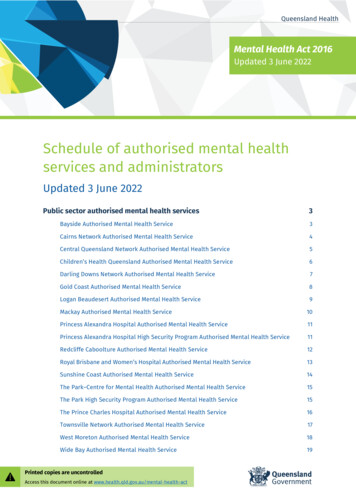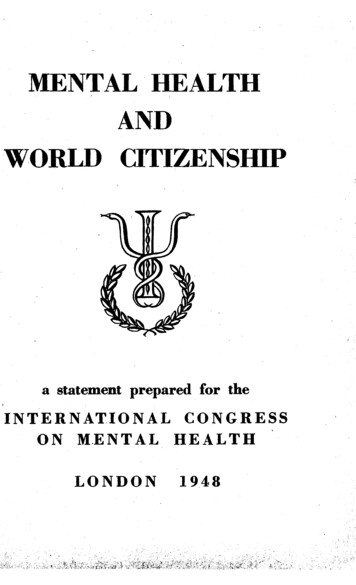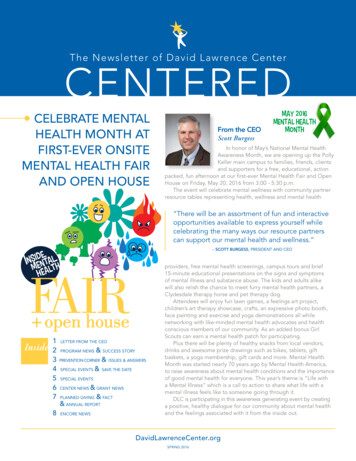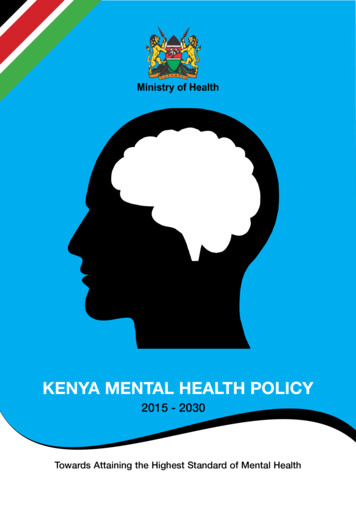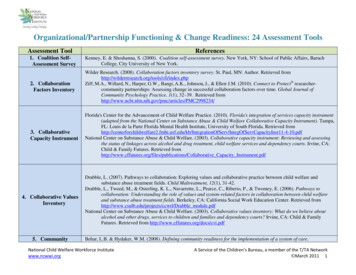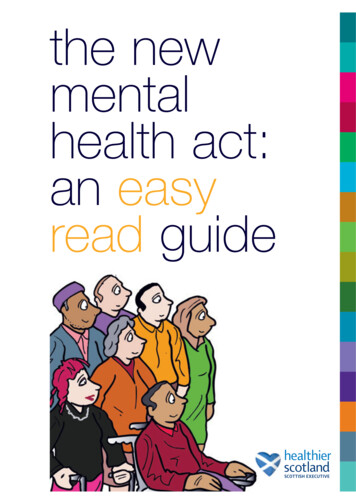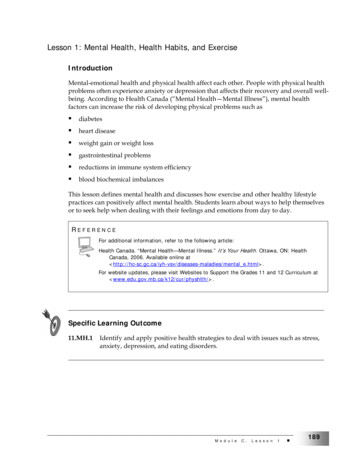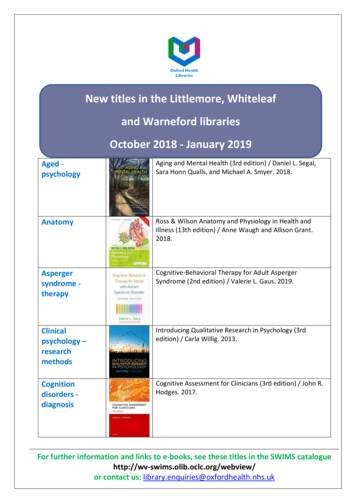
Transcription
Depression BasicsNational Instituteof Mental HealthDo you feel sad, empty, andhopeless most of the day, nearlyevery day? Have you lost interestor pleasure in your hobbies orbeing with friends and family? Areyou having trouble sleeping, eating,and functioning? If you have feltthis way for at least 2 weeks, youmay have depression, a serious buttreatable mood disorder.National Instituteof Mental Health
What is depression?Everyone feels sad or low sometimes, but these feelings usually passwith a little time. Depression—also called “clinical depression” or a“depressive disorder”—is a mood disorder that causes distressingsymptoms that affect how you feel, think, and handle daily activities,such as sleeping, eating, or working.To be diagnosed with depression,symptoms must be present most of the day, nearly every day for atleast 2 weeks.What are the different types of depression?Two of the most common forms of depression are: Major depression—having symptoms of depression most of theday, nearly every day for at least 2 weeks that interfere with yourability to work, sleep, study, eat, and enjoy life. An episode canoccur only once in a person’s lifetime, but more often, a personhas several episodes. Persistent depressive disorder (dysthymia)—havingsymptoms of depression that last for at least 2 years. A persondiagnosed with this form of depression may have episodes ofmajor depression along with periods of less severe symptoms.Some forms of depression are slightly different, or they may developunder unique circumstances, such as: Perinatal Depression: Women with perinatal depressionexperience full-blown major depression during pregnancy or afterdelivery (postpartum depression). Seasonal Affective Disorder (SAD): SAD is a type ofdepression that comes and goes with the seasons, typicallystarting in the late fall and early winter and going away during thespring and summer. Psychotic Depression: This type of depression occurs whena person has severe depression plus some form of psychosis,such as having disturbing false fixed beliefs (delusions) or hearingor seeing upsetting things that others cannot hear or see(hallucinations).Other examples of depressive disorders include disruptive mooddysregulation disorder (diagnosed in children and adolescents) andpremenstrual dysphoric disorder. Depression can also be one phaseof bipolar disorder (formerly called manic-depression). But a personwith bipolar disorder also experiences extreme high—euphoric orirritable—moods called “mania” or a less severe form called“hypomania.”You can learn more about these disorders on the National Instituteof Mental Health (NIMH)’s website (www.nimh.nih.gov).What causes depression?Scientists at NIMH and across the country are studying the causes ofdepression. Research suggests that a combination of genetic, biological,environmental, and psychological factors play a role in depression.
Depression can occur along with other serious illnesses, such asdiabetes, cancer, heart disease, and Parkinson’s disease. Depression canmake these conditions worse and vice versa. Sometimes medicationstaken for these illnesses may cause side effects that contribute todepression symptoms. For more information on ongoing research ondepression, visit www.nimh.nih.gov.What are the signs and symptomsof depression?Sadness is only one small part of depression and some people withdepression may not feel sadness at all. Different people have differentsymptoms. Some symptoms of depression include: Persistent sad, anxious, or “empty” mood Feelings of hopelessness or pessimism Feelings of guilt, worthlessness, or helplessness Loss of interest or pleasure in hobbies or activities Decreased energy, fatigue, or being “slowed down” Difficulty concentrating, remembering, or making decisions Difficulty sleeping, early-morning awakening, or oversleeping Appetite and/or weight changes Thoughts of death or suicide or suicide attempts Restlessness or irritability Aches or pains, headaches, cramps, or digestive problems without aclear physical cause and/or that do not ease even with treatmentDoes depression look the same in everyone?No. Depression affects different people in different ways. For example:Women have depression more often than men. Biological, lifecycle,and hormonal factors that are unique to women may be linked to theirhigher depression rate.Women with depression typically have symptomsof sadness, worthlessness, and guilt.Men with depression are more likely to be very tired, irritable, andsometimes angry. They may lose interest in work or activities theyonce enjoyed, have sleep problems, and behave recklessly, including themisuse of drugs or alcohol. Many men do not recognize theirdepression and fail to seek help.Older adults with depression may have less obvious symptoms, orthey may be less likely to admit to feelings of sadness or grief. They arealso more likely to have medical conditions, such as heart disease,which may cause or contribute to depression.Younger children with depression may pretend to be sick, refuse togo to school, cling to a parent, or worry that a parent may die.Older children and teens with depression may get into trouble atschool, sulk, and be irritable.Teens with depression may have symptomsof other disorders, such as anxiety, eating disorders, or substance abuse.
How is depression treated?The first step in getting the right treatment is to visit a health careprovider or mental health professional, such as a psychiatrist orpsychologist.Your health care provider can do an exam, interview,and lab tests to rule out other health conditions that may have thesame symptoms as depression. Once diagnosed, depression can betreated with medications, psychotherapy, or a combination of thetwo. If these treatments do not reduce symptoms, brain stimulationtherapy may be another treatment option to explore.MEDICATIONSMedications called antidepressants can work well to treatdepression.They can take 2 to 4 weeks to work. Antidepressants canhave side effects, but many side effects may lessen over time. Talk toyour health care provider about any side effects that youhave. Do not stop taking your antidepressant withoutfirst talking to your health care provider.Please Note: Although antidepressants can be effective formany people, they may present serious risks to some, especiallychildren, teens, and young adults. Antidepressants may causesome people, especially those who become agitated when theyfirst start taking the medication and before it begins to work,to have suicidal thoughts or make suicide attempts. Anyone takingantidepressants should be monitored closely, especially when theyfirst start taking them. For most people, though, the risks ofuntreated depression far outweigh those of antidepressantmedications when they are used under a doctor’s carefulsupervision.Information about medications changes frequently. Visit theU.S. Food and Drug Administration (FDA) website for the latestwarnings, patient medication guides, or newly approved medications.PSYCHOTHERAPYPsychotherapy helps by teaching new ways of thinking andbehaving, and changing habits that may be contributing todepression. Therapy can help you understand and work throughdifficult relationships or situations that may be causing yourdepression or making it worse.BRAIN STIMULATION THERAPIESElectroconvulsive therapy (ECT) and other brain stimulationtherapies may be an option for people with severe depression whodo not respond to antidepressant medications. ECT is the beststudied brain stimulation therapy and has the longest history of use.Other stimulation therapies discussed here are newer, and in somecases still experimental methods. For more information on thesetreatment options, visit www.nimh.nih.gov/health. To find clinicaltrials, visit www.clinicaltrials.gov.
How can I help myself if I am depressed?As you continue treatment, you may start to feel better gradually.Remember that if you are taking an antidepressant, it may take2 to 4 weeks to start working. Try to do things that you used toenjoy. Go easy on yourself. Other things that may help include: Trying to be active and exercise Breaking up large tasks into small ones, set priorities, and do whatyou can as you can Spending time with other people and confide in a trusted friendor relative Postponing important life decisions until you feel better. Discussdecisions with others who know you well Avoiding self-medication with alcohol or with drugs not prescribedfor youHow can I help a loved one who is depressed?If you know someone who has depression, first help him or her see ahealth care provider or mental health professional.You can also: Offer support, understanding, patience, and encouragement Never ignore comments about suicide, and report them to yourloved one’s health care provider or therapist Invite him or her out for walks, outings, and other activities Help him or her adhere to the treatment plan, such as settingreminders to take prescribed medications Help him or her by ensuring that he or she has transportation totherapy appointments Remind him or her that, with time and treatment, the depressionwill liftWhere can I go for help?If you are unsure where to go for help, ask your health provideror check out the NIMH Help for Mental Illnesses webpage atwww.nimh.nih.gov/findhelp. Another Federal health agency, theSubstance Abuse and Mental Health Services Administration (SAMHSA),maintains an online Behavioral Health Treatment Services Locator athttps://findtreatment.samhsa.gov/. You can also check online formental health professionals; contact your community health center,local mental health association, or insurance plan to find a mentalhealth professional. Hospital doctors can help in an emergency.If you or someone you know is in crisis, gethelp quickly. Call your or your loved one’s health professional.Call 911 for emergency services.Go to the nearest hospital emergency room.Call the toll-free, 24-hour hotline of the National SuicidePrevention Lifeline at 1-800-273-TALK (1-800-273-8255);TYY: 1-800-799-4TTY (4889).
ReprintsThis publication is in the public domain and may be reproduced orcopied without permission from NIMH. Citation of NIMH as asource is appreciated. We encourage you to reproduce it and use itin your efforts to improve public health. However, using governmentmaterials inappropriately can raise legal or ethical concerns, so weask you to use these guidelines: NIMH does not endorse or recommend any commercialproducts, processes, or services, and our publications may not beused for advertising or endorsement purposes. NIMH does not provide specific medical advice or treatmentrecommendations or referrals; our materials may not be used in amanner that has the appearance of providing such information. NIMH requests that non-Federal organizations not alter ourpublications in ways that will jeopardize the integrity and “brand”when using the publication. The addition of non-Federal Government logos and website linksmay not have the appearance of NIMH endorsement of any specificcommercial products or services, or medical treatments or services. Images used in publications are of models and are used forillustrative purposes only. Use of some images is restricted.If you have questions regarding these guidelines and use of NIMHpublications, please contact the NIMH Information Resource Centerat 1-866-615-6464 or e-mail nimhinfo@nih.gov.For More InformationFor more information on conditions that affect mental health,resources, and research, go to MentalHealth.govat www.mentalhealth.gov, or the NIMH website atwww.nimh.nih.gov. In addition, the National Library of Medicine’sMedlinePlus service (www.nlm.nih.gov/medlineplus/) hasinformation on a wide variety of health topics, including conditionsthat affect mental health.NATIONAL INSTITUTE OF MENTAL HEALTHOffice of Science Policy, Planning, and CommunicationsScience Writing, Press, and Dissemination Branch6001 Executive BoulevardRoom 6200, MSC 9663Bethesda, MD 20892-9663Phone: 301-443-4513 or 1-866-615-NIMH (6464) toll-freeTTY: 301-443-8431 or 1-866-415-8051 toll-freeFax: 301-443-4279Email: nimhinfo@nih.govWebsite: www.nimh.nih.govU.S. DEPARTMENT OF HEALTHAND HUMAN SERVICESNational Institutes of HealthNIH Publication No. TR 16-3561Revised 2016
Perinatal Depression: Women with perinatal depression experience full-blown major depression during pregnancy or after delivery (postpartum depression). Seasonal Affective Disorder (SAD): SAD is a type of depression that comes and goes with the seasons, typically starting in the late fall and early winter and going away during the

